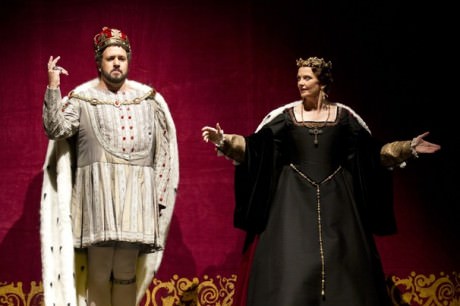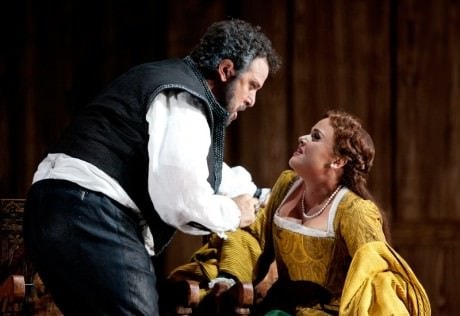The Washington National Opera’s season opened Saturday with a highly anticipated role debut. Celebrated Verdi specialist Sondra Radvanovsky, in a departure from her usual spinto repertory, took on the bel canto challenges of the title role in Donizetti’s Anna Bolena. While short of an outright triumph, the occasion proved a successful one for the soprano, who created a compelling and often thrilling vocal and dramatic portrait of the doomed heroine.

Director Stephen Lawless’ production, imported from the Dallas Opera, veers uneasily between realist historical drama and symbolic abstraction. The story of the conflict between Henry VIII and Anne Boleyn plays out on Benoit Dugardyn’s set, based upon Shakespeare’s Globe Theatre, in a gesture toward ideas about theatricality and spectatorship. The shifting, claustrophobic paneled walls and high balconies from which the chorus comments on the action are meant to reflect the blurring of the public and private spheres. Throughout the evening, the historical dimension intrudes upon the personal lives and psychological dramas of the characters.
Yet beyond these broad conceptual outlines, the direction appears to be a grab bag of ideas that often seem imposed upon the drama rather than organically rising out of the action. Lawless’s individual choices range from inoffensive (the introduction of Princess Elizabeth as a silent character) to heavy-handed (a hunt portrayed symbolically by a wrestling match between two men wearing deer’s antlers, reflecting the casual brutality of life at court) to deleterious (Percy’s attempted suicide in Anna’s bedroom instead becomes an abortive rape attempt, undercutting his character’s nobility). When Lawless adopts a more minimalist storytelling language in the second act, the action – freed from distracting stage business – emerges with greater clarity and sharper focus on the characters’ interiority.

Radvanovsky’s virtues as a performer, thankfully, transcend the production’s limitations. While not possessing an ideal bel canto voice, Radvanovsky nonetheless sings with thrilling power, rare beauty, and dramatic intensity. She brings an inherent dignity and gravitas to the role, poignantly capturing the character’s ennobled suffering, while the thrill of her forte outbursts reminds us of her inner fire and resolution. It is a near complete vocal and dramatic portrayal, capturing the full richness of Anna’s character, from romantic yearning, melancholic nostalgia, and righteous anger to madness, spiritual strength, and, finally, tragic catharsis. Only a certain lack of precision in the soprano’s singing at high speeds detracts from an otherwise impressive and undeniably arresting role debut.
The supporting cast, as often is the case in WNO productions, is, alas, a mixed bag. In the pivotal role of Giovanni Seymour, the mezzo Sonia Ganassi is the standout. While possessing a smaller-scaled voice than Radvanovsky, Ganassi matches the soprano in dramatic effectiveness and sings with precision, a well-rounded tone, beautiful lyricism, and dramatic urgency when called upon. The riveting Act Two duet featuring Radvanovsky and Ganassi, sung with exhilarating power, passionate intensity, and volatile dramatic fireworks, provides the vocal high point of the performance.

As Enrico (Henry) VIII, Oren Gradus blusters in cartoon villain fashion and relies upon kingly mannerisms rather than vocal or dramatic nuance. He has little chemistry with either Radvanovsky or Ganassi, and several key scenes fail to ignite. Shalva Mukeria, exhibiting a constricted upper register, only intermittently captures Percy’s nobility and heroic stature but excels in portraying his pathos. Kenneth Kellogg is a firm-voiced Rochefort, while Claudia Huckle is a somewhat cloudy-voiced Smeton.
In the pit, Antonello Allemandi, for most of Act One, favors measured tempos and thicker textures, sacrificing rhythmic vitality and dramatic tension. Only in the first act finale does Allemandi finally let his orchestral forces loose, though at the cost of some coordination problems between the pit and the singers. Act Two proves a more idiomatic experience for the conductor, whose interpretation nonetheless could stand more polish and propulsive force.

Running Time: Three hours, with one 20-minute intermission.
Anna Bolena plays through October 6, 2012 at the Kennedy Center Opera House – 2700 F Street, NW, in Washington DC. For tickets, call (202) 467- 4600, or purchase them online.




